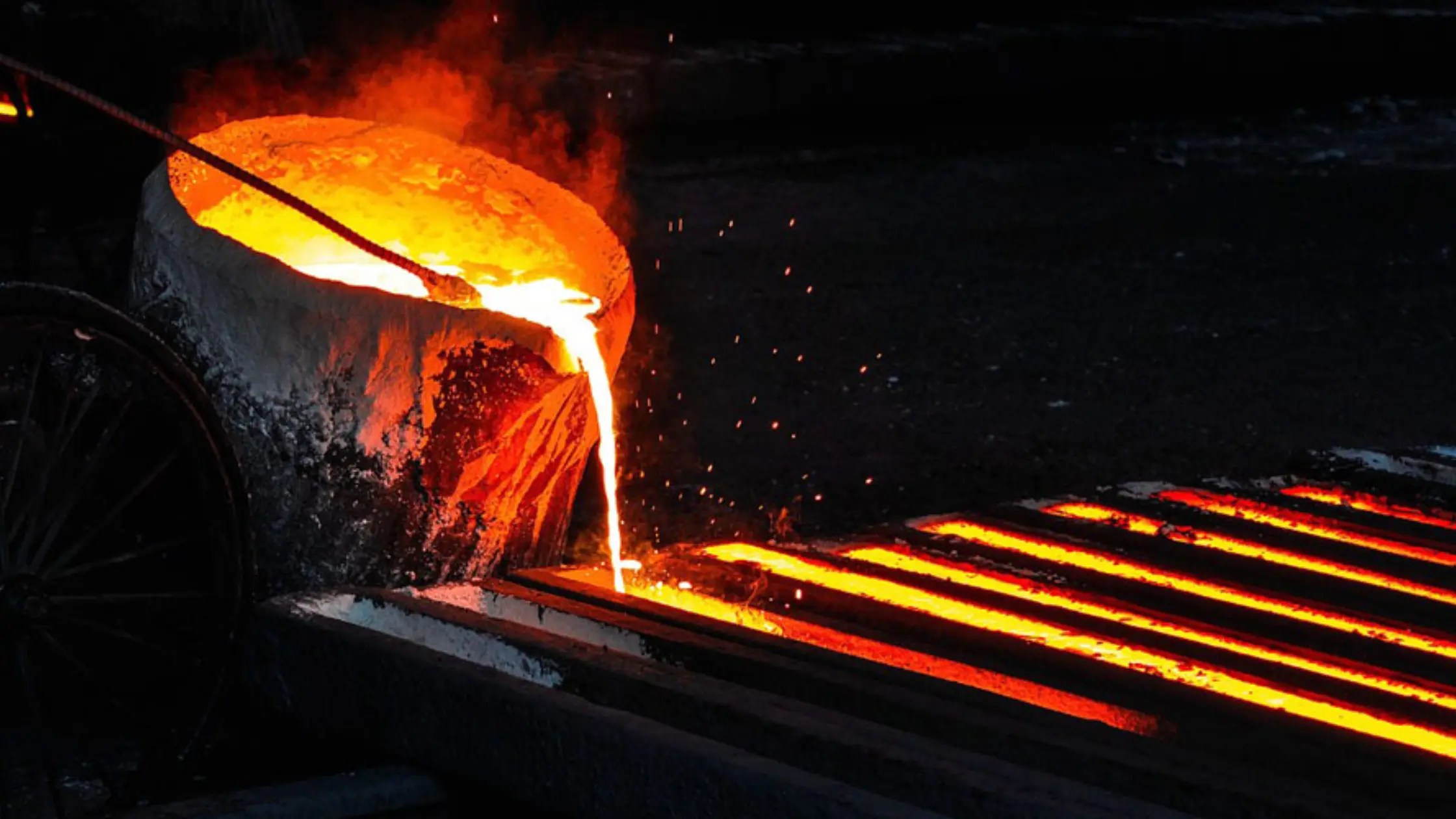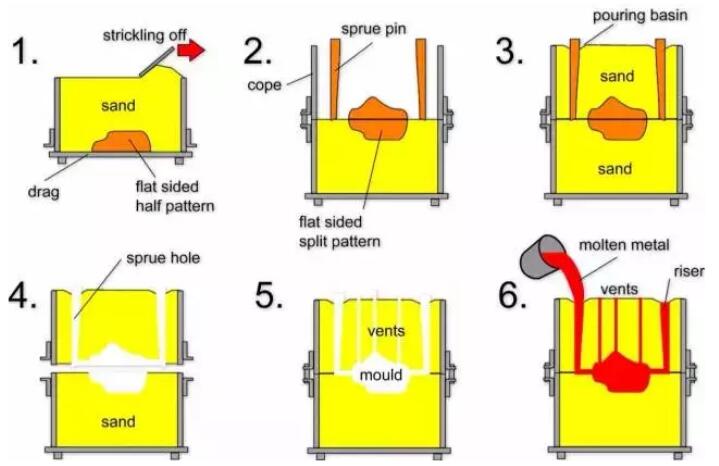Comprehending the Metal Castings Refine: A Comprehensive Overview for Beginners
The Metal Casting process is a basic technique in making that transforms molten metal right into strong kinds. Novices must comprehend the different methods entailed, such as sand spreading and pass away casting. Understanding the products, style concepts, and safety and security procedures is just as essential. Each facet plays a vital function in attaining successful end results. As one navigates these ins and outs, the concern of exactly how to maximize each step for improved outcomes ends up being increasingly essential.
The Basics of Steel Casting
Although Metal Casting has progressed over centuries, its fundamental concepts continue to be consistent and important to the manufacturing procedure. At its core, Metal Casting entails the transformation of molten steel right into strong items via various methods. The process starts with the production of a mold, which specifies the shape of the final product. When the mold and mildew is prepared, steel is warmed to its melting point and poured into the dental caries. After cooling, the metal solidifies, taking the shape of the mold.
There are several casting approaches, consisting of sand spreading, financial investment casting, and die spreading, each with unique benefits and applications. The selection of technique depends on elements such as production quantity, material kind, and wanted accuracy. As soon as cast, the end product might undergo additional procedures like machining or surface area treatment to achieve the required finish and specifications. Comprehending these essentials is crucial for any person curious about the area of Metal Casting.

Recognizing Materials Utilized in Steel Casting
Products play an essential function in the Metal Casting process, affecting the end product's residential properties and performance. Different steels are used, consisting of light weight aluminum, steel, bronze, and iron, each offering distinctive qualities suited for certain applications. Light weight aluminum is corrosion-resistant and lightweight, making it optimal for auto parts. Iron, especially cast iron, is preferred for its superb wear resistance and sturdiness. Steel supplies high toughness and versatility, typically utilized in hefty equipment parts. Bronze, known for its rust resistance and machinability, is generally used in aquatic applications.
In enhancement to the steels, numerous casting products, such as sand, plaster, and ceramic, are made use of to create molds. Sand casting, the most prevalent approach, utilizes silica sand as a result of its thermal stability and ability to create detailed forms. Plaster and ceramic mold and mildews use finer details yet might need more complex processes. The option of products straight impacts the performance, expense, and top quality of the spreading procedure.
The Layout Refine: From Concept to Plan
The style process in Metal Casting starts with the preliminary principle development, where ideas are created and assessed. This is complied with by the application of CAD modeling strategies, permitting exact visualizations of the layout. The blueprint completion steps guarantee that all specs are precisely documented for production.
Initial Principle Growth
First idea growth marks an important stage in the Metal Casting process, where ideas change into substantial layouts. Throughout this stage, designers collaborate with stakeholders and engineers to brainstorm and fine-tune preliminary principles. They consider aspects such as functionality, aesthetic appeals, and manufacturability, making sure that the layout satisfies the needed specifications and efficiency criteria. Sketches and outlines are produced to imagine the concepts, enabling preliminary evaluations of usefulness and cost-effectiveness. This stage likewise entails identifying products and potential casting techniques that align with the style objectives. Inevitably, initial principle development prepares for a complete plan, leading the succeeding stages of the casting procedure and ensuring a successful change from principle to reality.
CAD Modeling Techniques
Transforming concepts into exact styles, CAD modeling techniques play a crucial role in the Metal Casting procedure. These strategies utilize sophisticated software application to produce in-depth three-dimensional designs that properly show the intended product. By utilizing tools such as parametric modeling, strong modeling, and surface area modeling, developers can adjust measurements and forms easily. CAD systems likewise assist in simulation and analysis, enabling for the recognition of prospective defects before manufacturing starts. This aggressive strategy lowers product waste and optimizes the design for manufacturability. Additionally, CAD models can be conveniently customized, allowing quick iterations based upon comments. Basically, CAD modeling offers as the foundation of the design process, connecting the space in between preliminary principles and the eventual production-ready styles.
Blueprint Finalization Tips
Complying with the creation of in-depth CAD designs, the following phase involves blueprint completion, which is essential in equating digital designs right into workable prepare for manufacturing. This procedure begins with reviewing the CAD versions for accuracy and conformity with specifications. As soon as confirmed, the dimensions, resistances, and material requirements are thoroughly detailed to assure clarity. Including notes and notes aids interact essential information pertaining to casting procedures, surface finishes, and assembly requirements. The finalized plan undergoes a rigorous authorization process, usually entailing collaboration with engineers and manufacturing groups to address any kind of potential problems. Besides alterations are made and approvals obtained, the blueprint is formally launched, working as the fundamental file for the succeeding phases of Metal Casting, including pattern making and mold layout.
The Metal Casting Methods Discussed

Metal Casting techniques incorporate a range of methods made use of to form molten steel right into preferred kinds. These methods differ according to the kind of product, intricacy of the layout, and manufacturing quantity. Sand casting is just one of the most typical methods, entailing the production of a mold and mildew from sand to hold the liquified steel. Financial investment spreading, or lost-wax spreading, enables detailed layouts by utilizing a wax pattern that is dissolved. Pass away casting employs high-pressure shot of molten metal right into a mold, ideal for automation. Various other techniques include permanent mold and mildew casting, which makes use of recyclable mold and mildews, and centrifugal casting, where rotational pressures help in filling the mold. Each strategy has its advantages and applications, making it essential for suppliers to choose the ideal method based upon their details needs and needs. Understanding these methods is vital for any individual associated with the Metal Casting procedure.
Finishing Processes: Enhancing Your Casted Product

Ending up procedures play an important duty in improving the high quality and look of casted products. Various surface area therapy methods, such as polishing and finishing, are utilized to enhance durability and looks. In addition, top quality inspection techniques guarantee that the final item satisfies defined criteria and performance needs.
Surface Therapy Techniques
A selection of surface area therapy strategies play an essential function in boosting the high quality and long life of casted products. These strategies include approaches such as shot blasting, polishing, and covering. Shot blowing up efficiently gets rid of surface blemishes, find out enhancing the aesthetic and practical attributes of the spreading. Polishing supplies a smooth finish, which is specifically essential for attractive applications and elements calling for minimal friction. read what he said Finishing strategies, such as electroplating or powder covering, offer extra defense versus corrosion and wear, making certain toughness. In addition, surface treatments can boost bond for succeeding processes, such as painting or bonding. By utilizing these methods, suppliers can attain remarkable surface top quality, which is vital for the efficiency and life-span of Metal Casting in different applications.
Top Quality Evaluation Approaches
Reliable high quality assessment techniques are vital for assuring the honesty and efficiency of casted items after the ending up processes. Different methods are employed to evaluate the quality of Metal Casting, including visual examination, dimensional checks, and non-destructive testing (NDT) Aesthetic examination enables the recognition of surface area problems, while dimensional checks guarantee that products fulfill defined resistances. NDT techniques, such as ultrasonic screening and radiographic examination, give much deeper insights into interior integrity without damaging the spreadings. Furthermore, mechanical testing, such as tensile and solidity tests, evaluates product homes - Wisconsin Aluminum Foundry. By utilizing a combination of these approaches, makers can boost item high quality and reliability, inevitably resulting in better client complete satisfaction and reduced manufacturing expenses
Safety Considerations in Metal Casting
While the Metal Casting procedure supplies various benefits, it likewise presents a variety of safety and security dangers that need to be very carefully handled. Workers in casting facilities are exposed to high temperatures, molten steels, and unsafe products, which can cause serious injuries if appropriate safety measures are not taken. Personal protective tools (PPE) such as heat-resistant gloves, deal with guards, and protective apparel is important to lessen risks.
Furthermore, the presence of fumes and dust demands proper ventilation systems to ensure air top quality - Wisconsin Aluminum Foundry. Regular training on security methods is vital for all workers to identify prospective hazards and react successfully. Emergency situation procedures ought to be developed, consisting of fire security procedures and emergency treatment schedule. Maintenance of devices and proper handling of materials additionally add to a safer working atmosphere. By prioritizing these security considerations, Metal Casting operations can secure their labor force and keep reliable manufacturing procedures
Regularly Asked Questions
What Are the Ecological Influences of Metal Casting?
Metal Casting can lead to environmental impacts such as air and water pollution, resource depletion, and energy consumption. In addition, inappropriate waste monitoring and exhausts from factories add to ecological disruptions and health risks for nearby neighborhoods.
Exactly how Do I Select the Right Metal for Casting?
To pick the appropriate steel for spreading, one have he said to take into consideration variables such as mechanical homes, rust resistance, thermal conductivity, and cost. Examining the designated application and environmental problems is crucial for excellent selection.
What Are the Common Flaws in Metal Casting?
Usual problems in Metal Casting consist of porosity, contraction, sand inclusion, and misruns. These issues commonly arise from incorrect product choice, inadequate layout, or imperfections in the spreading procedure, impacting the final item's high quality and performance.
Exactly How Can I Enhance My Steel Casting Skills?
To enhance Metal Casting abilities, one need to exercise consistently, research study casting techniques, evaluate previous jobs for issues, look for responses from seasoned casters, and continually explore different products and methods to improve effectiveness and understanding.
What Is the Price of Beginning a Steel Spreading Organization?
Starting a metal casting business normally calls for a preliminary investment of $5,000 to $50,000, depending on equipment, materials, and center costs. Elements like place and scale can considerably affect total start-up expenses.
The Metal Casting procedure is a fundamental method in making that changes molten steel right into solid forms. Beginners must comprehend the various methods included, such as sand spreading and pass away spreading. There are a number of casting methods, including sand casting, financial investment spreading, and die casting, each with unique benefits and applications. Financial investment casting, or lost-wax casting, enables for elaborate layouts by making use of a wax pattern that is melted away. Various other approaches include permanent mold casting, which makes use of recyclable molds, and centrifugal casting, where rotational pressures aid in filling up the mold.